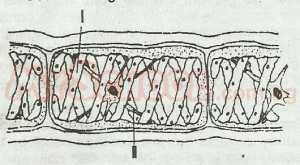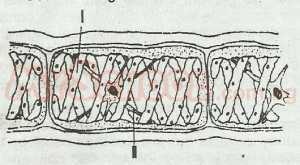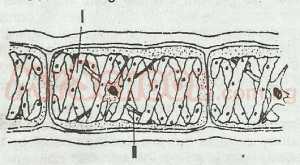Year :
1997
Title :
Biology
Exam :
WASSCE/WAEC MAY/JUNE
Paper 1 | Objectives
1 - 10 of 59 Questions
| # | Question | Ans |
|---|---|---|
| 1. |
Which of the following organism possesses both plant and animal characteristics? A. Amoeba B. Paramecium C. Euglene D. Mucor E. Nitrobacter |
C |
| 2. |
 The structure represented in the diagram above is A. a colony B. a tissue C. a filament D. a pseudopodium E. an organ |
C |
| 3. |
 The part labelled I in the diagram is the A. cytoplasm B. chloroplast C. chlorophyll D. nucleus E. cell wall |
B |
| 4. |
 What is the function of the part labelled II in the diagram? It A. manufactures food B. protects the chloroplast C. produces protein D. suspends the nucleus E. digests starch |
D |
| 5. |
Which of the following organelles helps to remove excess water A. Mitochondrion B. Ribosome C. Contractile vacuole D. Golgi body E. Nucleus |
C |
| 6. |
Which of the following processes occurs by diffusion? A. Reabsorption of water in kidney tubules B. Entry of water into the cytoplasm of unicellular animals C. Absorption of water in the large intestine D. Exchange of nutrients between a mother and the foetus E. Movement of water in and out of living cells. |
D |
| 7. |
Which of the following is a product of brewing when yeast is used as a fermenting agent? A. Nitrogen B. Oxygen C. Malt D. Ethanol E. Sucrose and glucose |
D |
| 8. |
Which of the following hind limb bones is equivalent to the humerus of the forelimb? A. Patella B. Tarsal C. Tibia D. Fibula E. Femur |
E |
| 9. |
Clotting of blood is a function of A. vitamin C B. vitamin K C. vitamin B2 D. vitamin E E. vitamin B12 |
B |
| 10. |
Which of the following structures is associated with respiration in insects? A. Air sac B. Spiracle C. Lung D. Alveolus E. Gill |
B |
| 1. |
Which of the following organism possesses both plant and animal characteristics? A. Amoeba B. Paramecium C. Euglene D. Mucor E. Nitrobacter |
C |
| 2. |
 The structure represented in the diagram above is A. a colony B. a tissue C. a filament D. a pseudopodium E. an organ |
C |
| 3. |
 The part labelled I in the diagram is the A. cytoplasm B. chloroplast C. chlorophyll D. nucleus E. cell wall |
B |
| 4. |
 What is the function of the part labelled II in the diagram? It A. manufactures food B. protects the chloroplast C. produces protein D. suspends the nucleus E. digests starch |
D |
| 5. |
Which of the following organelles helps to remove excess water A. Mitochondrion B. Ribosome C. Contractile vacuole D. Golgi body E. Nucleus |
C |
| 6. |
Which of the following processes occurs by diffusion? A. Reabsorption of water in kidney tubules B. Entry of water into the cytoplasm of unicellular animals C. Absorption of water in the large intestine D. Exchange of nutrients between a mother and the foetus E. Movement of water in and out of living cells. |
D |
| 7. |
Which of the following is a product of brewing when yeast is used as a fermenting agent? A. Nitrogen B. Oxygen C. Malt D. Ethanol E. Sucrose and glucose |
D |
| 8. |
Which of the following hind limb bones is equivalent to the humerus of the forelimb? A. Patella B. Tarsal C. Tibia D. Fibula E. Femur |
E |
| 9. |
Clotting of blood is a function of A. vitamin C B. vitamin K C. vitamin B2 D. vitamin E E. vitamin B12 |
B |
| 10. |
Which of the following structures is associated with respiration in insects? A. Air sac B. Spiracle C. Lung D. Alveolus E. Gill |
B |